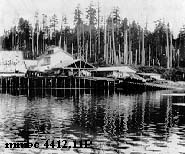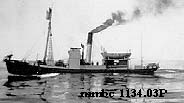
|
& |

|

|
& |

|
 The Sealer Diana mmbc 920P |
Victoria was the center for Pacific sealing and whaling activities for fifty years. Open water sealing reached its peak in the last two decades of the 19th century when more than 60 sealing vessels could be seen moored in Victoria's Upper Harbour. Approxi mately 1,500 people were employed in this industry, including a significant number of First Nations peoples. Every summer the sealers followed the seal herds north to their breeding grounds in the Bering Sea. International concern for the dwindling popula tion of seals in the Bering Sea led to a ban on sealing in this area in the 1890's. |
| Commercial whaling began in B.C. in the mid-1800's, by which time special whaling vessels had been designed. By the early 1900's several whaling stations had been built along the west coast. Whaling became a small-scale industry along the east coast of Vancouver Island in the Strait of Georgia, in Saanich Inlet, and north at Cortes Island (where a community is still named 'Whaletown'). Soon the whale population was reduced and the whaling companies closed their operations. |
 Whaling Staion at Rose Harbour mmbc 4512.11 |
|

|
Although firms such as the Pacific Whaling Company worked along the west coast for several years, international competition made the whaling business on the coast unprofitable by the 1920's. By the 1960's, whales were becoming scarce along the coast and m any species were near extinction. International concern brought about legislation that outlawed whaling in this region in 1967. | |
Whale oil, as well as black shark oil, were in high demand during the late 19th century as effective lubricants. One business that sold shark oil was the Skidegate Oil Company of Victoria.
| Ambergris (derived from the French 'ambre gris', or grey amber) was one of the products taken from the whale. A light inflammable fatty substance found in the intestines of sperm whales, it occurs in lumps from a few ounces to several hundred pounds and w as used extensively in the preparation of perfumes. |
 Scrimshaw mmbc collection |
Inside the mouth of the baleen whale is whalebone that consists of plates that have bristles to trap the small marine organisms the whale feeds on. These plates, called baleen, became a sought-after product in the 19th century when they had considerable industrial value, particularly in corsetry, because of their flexibility, springiness and strength. |
 Whaling Ship mmbc 1134.03P |
Whaling was a well established part of the lifestyle of the First Nations peoples of the northwest coast when Cook arrived. Although not all West Coast peoples were whalers, Maquinna was famous for his whaling talent and his forefathers had been whaling for centuries. The peoples of Clayuquot Sound, Nootka Sound, Cape Flattery, and Tofino Inlet were also involved in whaling. |
| While non-First Nations peoples used harpoon cannons to capture whales for profitable whale oil and baleen industries, the West Coast approach to hunting creatures of the sea was quite different. Using an elaborate ritual, the West Coast people communicated on a spiritual level with the animal they sought to kill, expressing empathy towards the creature for the life it was to give up in order that they might continue to live. The ritual was designed to influence the whale to surrender itself, and a eulogy was sung by the chief to the whale before it was finally killed. |
| From the Raincoast Chronicles First Five. pp. 21-28 by Arsdell, J.V. |


![[English]](../simages/english.gif)
|

![[French]](../simages/french.gif)
|

![[Credits]](../simages/credit.gif)
|

![[Feedback]](../simages/feedback.gif)
|